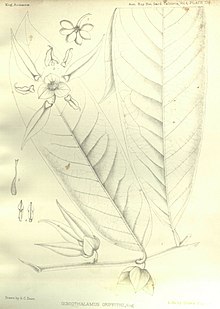Goniothalamus griffithii
Goniothalamus griffithii is a species of plant in the family Annonaceae. It is native to Myanmar and Thailand.[2] Joseph Dalton Hooker and Thomas Thomson the British botanists who first formally described the species, named it in honor of William Griffith, another British botanist who collected the specimen they examined.[3]
| Goniothalamus griffithii | |
|---|---|
 | |
| Botanical illustration of Goniothalamus griffithii.[1] | |
| Scientific classification | |
| Kingdom: | Plantae |
| Clade: | Tracheophytes |
| Clade: | Angiosperms |
| Clade: | Magnoliids |
| Order: | Magnoliales |
| Family: | Annonaceae |
| Genus: | Goniothalamus |
| Species: | G. griffithii |
| Binomial name | |
| Goniothalamus griffithii | |
Description
Its rough branches are dark gray. It has oblong, hairless, leathery leaves are 16.2 - 21.6 by 6.75 - 8.1 centimeters. The leaves are covered in minute translucent impressions. The undersides of the leaves are paler than the upper surfaces. Its petioles are 1.3 centimeters long. Its bent peduncles are the same length as its petioles and are scaly at their base. Its 1.8 centimeter long, rounded sepals are united at their base, covered in minute, fine hairs. Its flowers have 6 petals in two rows of 3. Its smooth, linear-oblong outer petals are thick and leathery and tapered at their base. The upper 1.3 centimeters of its inner petals are joined at their margins. Its stamen are linear-oblong with a fleshy tip that extends above the anthers. Its gynoecium have ovaries that are covered in short rigid hairs and styles that have fluted ends.[3]
Reproductive Biology
Pollen is shed as permanent tetrads.[4]
Uses
Bioactive molecules isolated from its roots have been reported to have cytotoxic activity in tests with cultured human cancer cells.[5][6][7]
References
- King, George (1893). "Anonaceae of British India". Annals of the Royal Botanic Garden, Calcutta. 4: plate 136. Retrieved June 15, 2020.
- "Goniothalamus griffithii Hook.f. & Thomson". Plants of the World Online. The Trustees of the Royal Botanic Gardens, Kew. n.d. Retrieved January 19, 2019.
- Hooker, Joseph Dalton; Thomson, Thomas (1855). Flora Indica (in English and Latin). London: W. Pamplin. p. 110.
- Saunders, Richard M. K.; Chalermglin, Piya (2008). "A synopsis of Goniothalamus species (Annonaceae) in Thailand, with descriptions of three new species". Botanical Journal of the Linnean Society. 156 (3): 355–384. doi:10.1111/j.1095-8339.2007.00762.x. ISSN 0024-4074.
- Zhang, Yan Jun; Zhou, Guang Xiong; Chen, Ruo Yun; Yu, De Quan (1999). "Styryllactones from the Rhizomes ofGoniothalamus griffithii". Journal of Asian Natural Products Research. 1 (3): 189–197. doi:10.1080/10286029908039864. ISSN 1028-6020.
- Banjerdpongchai, Ratana; Khaw-on, Patompong; Pompimon, Wialrt (201). "Phytochemicals from Goniothalamus griffithii Induce Human Cancer Cell Apoptosis". Asian Pacific Journal of Cancer Prevention. 17 (7): 3281–3287.
- Mu, Qing; Tang, Wei Dong; Liu, Ruo Yan; Li, Chao Ming; Lou, Li Guang; Sun, Han Dong; Hu, Chang Qi (2003). "Constituents from the Stems ofGoniothalamus griffithii". Planta Medica. 69 (9): 826–830. doi:10.1055/s-2003-43219. ISSN 0032-0943.